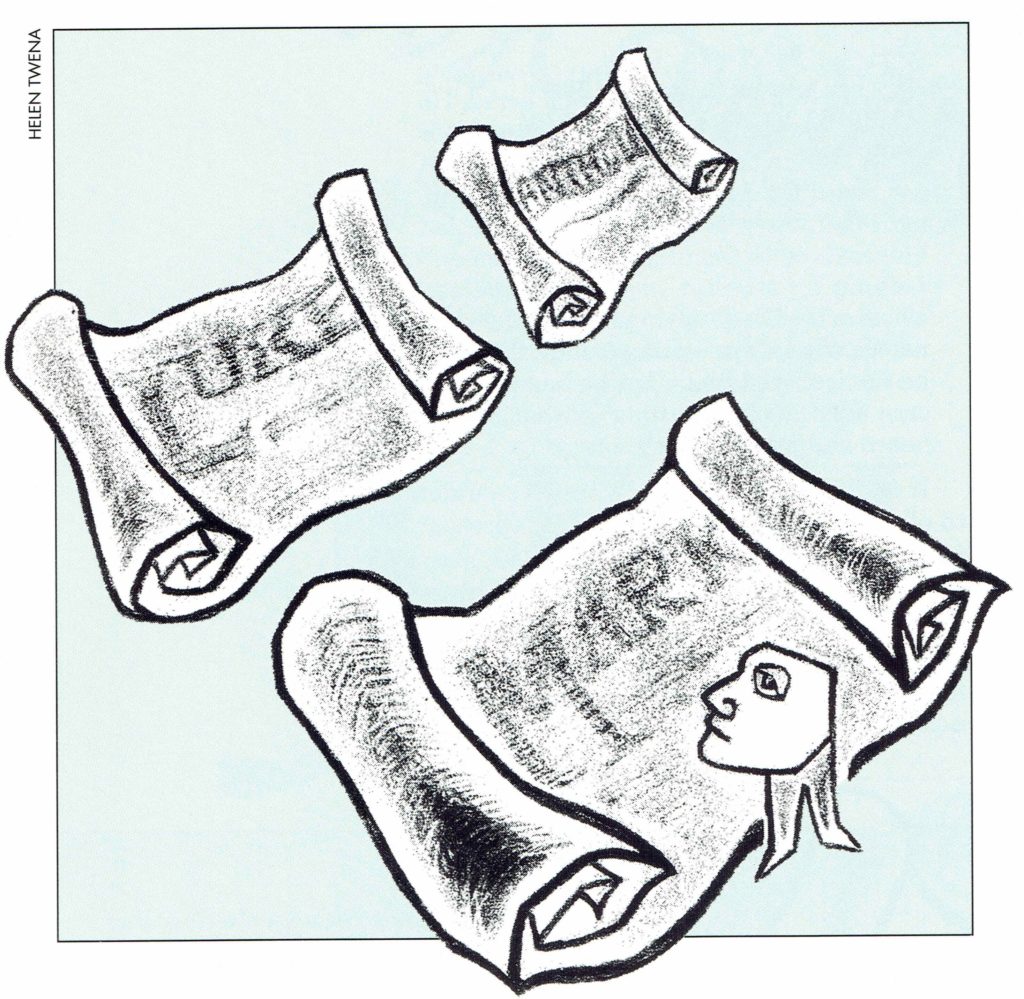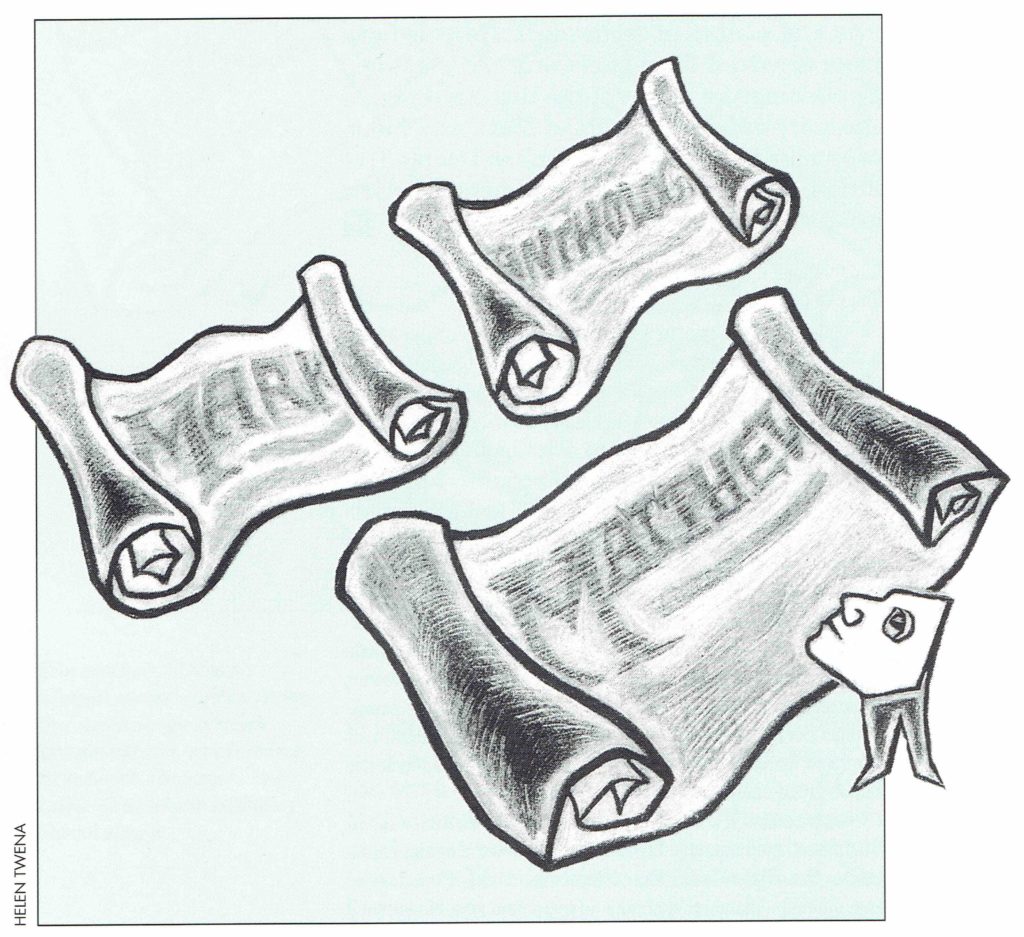How to cite this article:
Joshua N. Tilton and David N. Bivin, “Be Ready for the Son of Man,” The Life of Yeshua: A Suggested Reconstruction (Jerusalem Perspective, 2024) [https://www.jerusalemperspective.com/29093/].
(Matt. 24:42; Mark 13:32-37; Luke 21:34-36)
(Huck 221, 222, 223, 225; Aland 293-296;
Crook 333, 334, 337)[101]
| Table of Contents |
|
1. Text 3. Conjectured Stages of Transmission 5a. Luke’s Version 5b. FR’s Version 5c. Mark’s Version 7. Conclusion |
Text
To view the text of Be Ready for the Son of Man click on the link below:
Premium Members and Friends of JP must be signed in to view this content.
If you are not a Premium Member or Friend, please consider registering. Prices start at $5/month if paid annually, with other options for monthly and quarterly and more: Sign Up For Premium
Conclusion

Be Ready for the Son of Man is an FR pericope, based on Faithful or Faithless Slave and Unexpected Thief, which the First Reconstructor composed as a paranetic conclusion to his expanded version of Jesus’ prophecy of destruction and redemption. Apart from adding an allusion to Isa. 24:17-20, the author of Luke left FR’s version of Be Ready for the Son of Man more or less intact.

On account of verbal and thematic similarities and his ability to see Anth.’s block of Son of Man-related sayings dealing with the future mission of the disciples, in which Faithful or Faithless Slave and Unexpected Thief occupied the same position as Be Ready for the Son of Man in Luke 21, the author of Mark was able to recognize that Be Ready for the Son of Man was a summary of Faithful or Faithless Slave and Unexpected Thief. He therefore used the Lukan/Anth. versions of Faithful or Faithless Slave and Unexpected Thief to amplify his version of Be Ready for the Son of Man.

Because of these Markan amplifications the author of Matthew was able to see that Mark’s version of Be Ready for the Son of Man was an abbreviated version of Faithful or Faithless Slave and Unexpected Thief. He therefore preserved only a small portion of Mark’s version of Be Ready for the Son of Man in order to insert Unexpected Thief and Faithful or Faithless Slave (Part Two) immediately after it. Because Be Ready for the Son of Man was composed entirely in Greek, we have not included it in the Life of Yeshua or attempted to reconstruct this pericope in Hebrew.
 Click here to return to The Life of Yeshua: A Suggested Reconstruction main page.
_______________________________________________________
Click here to return to The Life of Yeshua: A Suggested Reconstruction main page.
_______________________________________________________
- [1] On the possibility that the author of Mark intended Day and Hour Unknown to be read as an authorial aside, rather than as a word of Jesus, see Redaction Analysis: Mark’s Version. ↩
- [2] Cf. Bundy, 472 §383. Beare was certainly correct to criticize references to Matt. 24:43-25:46 as merely an addendum to the eschatological discourse. See Francis W. Beare, “The Synoptic Apocalypse: Matthean Version,” in Understanding the Sacred Text: Essays in honor of Morton S. Enslin on the Hebrew Bible and Christian Beginnings (ed. John Reumann; Valley Forge, Pa.: Judson Press, 1972), 117-133, esp. 131. Matthew’s version of the eschatological discourse can be divided into three main parts: 1) Condemnation of Israel (Matt. 23:1-39); 2) Apocalyptic Predictions (Matt. 24:1-41); 3) Ethical Instruction in view of the Parousia (Matt. 24:42-25:46). ↩
- [3] See Days of the Son of Man, Comment to L1-6. ↩
- [4] Cf. Nolland, Matt., 994. ↩
- [5] Cf. Beare, “The Synoptic Apocalypse: Matthean Version,” 131. ↩
- [6] Cf. Allen, 261. ↩
- [7] See C. H. Dodd, The Parables of the Kingdom (rev. ed.; New York: Charles Scribner’s Sons, 1961), 130. Cf. Kilpatrick, 89; Bundy, 472 §383; Beare, “The Synoptic Apocalypse: Matthean Version,” 130; Davies-Allison, 3:383. ↩
- [8] Cf. Kilpatrick, 89; Luz, 3:216. ↩
- [9] See our introduction to the “Destruction and Redemption” complex. ↩
- [10] Scholars working from the Two-source Hypothesis, which posits Markan Priority, generally presume that Luke’s version of Be Ready for the Son of Man depends on Mark’s or is Luke’s substitute for Mark’s version. See Manson, Sayings, 335; Bundy, 472 §384; Marshall, 781; Bovon, Luke, 3:124. Cf. Jeremias, Parables, 78 n. 28. ↩
- [11] Neither Proportionality (Luke 12:47-48) nor Immersion of Fire (Luke 12:49-50) occur in Matthew, but they could have belonged to the Anth. cluster under discussion. Proportionality continues the theme of reward and punishment from Faithful or Faithless Slave and could therefore have been included within the cluster. Immersion of Fire, which mentions a judgment Jesus was to bring upon the earth, could have been understood as referring to Jesus’ role as a judge in his capacity as the Son of Man. ↩
- [12] Many scholars theorize some relationship between Mark’s version of Be Ready for the Son of Man and the sayings in Luke 12:35-46. See Bacon, 188; Bultmann, 119; Gundry, Mark, 2:796; Evans, 340-341; France, Mark, 541-542; Marcus, 2:920. See also Richard Bauckham, “Synoptic Parousia Parables and the Apocalypse,” New Testament Studies 23.2 (1976): 162-176, esp. 166. Some scholars suspect that Mark’s version of Be Ready for the Son of Man is also related to the Entrusted Funds parable, since it is similar to the opening of Matthew’s version (Matt. 25:14-30). See Bacon, 188; Bundy, 471-472 §383. However, it is a priori more likely that the author of Matthew modeled the opening of his redacted version of the Entrusted Funds parable on the simile in Mark’s version of Be Ready for the Son of Man, which the author of Matthew omitted, than that Mark reflects a pre-synoptic version of the Talents parable that resembles what we now read in Matthew. ↩
- [13] Cf. Allen, 262; Fitzmyer, 2:985; Nolland, Matt., 994 n. 142. ↩
- [14] Cf. Gundry, Matt., 494; Fitzmyer, 2:984-985; Nolland, Luke, 2:699; Hagner, 2:722; Davies-Allison, 3:383; Luz, 3:216; Nolland, Matt., 994; Culpepper, 482. ↩
- [15] Like us, Bauckham supposed that Luke 12:35-46 already existed as a unit in a pre-synoptic source. See Bauckham, “Synoptic Parousia Parables and the Apocalypse,” 165-166. ↩
- [16] Cf. Luz, 3:216 n. 5. ↩
- [17] Cf. Plummer, Luke, 486; Creed, 259; Manson, Sayings, 335; Metzger, 173; Marshall, 782; Fitzmyer, Luke, 2:1356; Wolter, 2:435. ↩
- [18] Cf. Plummer, Luke, 486; Manson, Sayings, 335; C. H. Dodd, “The ‘Primitive Catechism’ and the Sayings of Jesus,” in his More New Testament Studies (Manchester: Manchester University Press, 1968), 11-29, esp. 20-24. Cf. Bultmann, 119. ↩
- [19] Cf. David Flusser, “The Dead Sea Sect and Pre-Pauline Christianity” (JOC, 23-74), esp. 26-27. ↩
- [20] Cf. Dodd, “The ‘Primitive Catechism’ and the Sayings of Jesus,” 20; Wolter, 2:434. ↩
- [21] See LOY Excursus: Sources of the “Strings of Pearls” in Luke’s Gospel, under the subheading “Matthean Parallels to Lukan ‘String of Pearls’ Sayings Lacking Doublets in Luke.” ↩
- [22] It is likely that Anth.’s version of Warning About Leavened Bread simply read, προσέχετε ἀπὸ τῆς ζύμης τῶν Φαρισαίων (“Beware of the leaven of the Pharisees!”) and that the First Reconstructor inserted ἑαυτοῖς (“of yourselves”) after προσέχετε and that he inserted the explanatory ἥτις ἐστὶν ὑπόκρισις (“which is hypocrisy”) between ἀπὸ τῆς ζύμης (“from the leaven”) and τῶν Φαρισαίων (“of the Pharisees”). This would explain why, in place of Mark’s ὁρᾶτε βλέπετε ἀπὸ τῆς ζύμης τῶν Φαρισαίων (“Watch [out]! Look [out] for the leaven of the Pharisees!”; Mark 8:15), Matthew reads, ὁρᾶτε καὶ προσέχετε ἀπὸ τῆς ζύμης τῶν Φαρισαίων (“Watch [out]! And beware of the leaven of the Pharisees!”; Matt. 16:6). According to his usual practice, the author of Matthew combined the wording of his two sources, Mark and Anth. See JP Staff Writer, “What Is the Leaven of the Pharisees?” Jerusalem Perspective (2023) [https://www.jerusalemperspective.com/26391/]. ↩
- [23] In Luke, Woes Against Scribes and Pharisees and Innocent Blood are presented as critical of the Pharisees. Since Warning About Leavened Bread is also critical of the Pharisees, it could be derived from the same source as the previous pericopae (i.e., FR). Moreover, the author of Luke tended to copy his sources in blocks rather than switch back and forth from one pericope to the next. ↩
- [24] See Creed, 258; Cadbury, Style, 176; Marshall, 782. ↩
- [25] It is possible that the two instances of προσέχετε ἑαυτοῖς in Acts (Acts 5:35; 20:28) are due to FR’s influence on the author of Luke’s writing style. ↩
- [26] Cf. Nolland, Luke, 3:1012. ↩
- [27] See Fitzmyer, 2:1355; Nolland, Luke, 3:1012; Wolter, 2:434. ↩
- [28] For more on Mark’s redactional practices, see LOY Excursus: Mark’s Editorial Style. ↩
- [29] Cf. Marshall, 782; Bovon, 3:122. ↩
- [30] For a refutation of the suggestion that κραιπάλη was a specialized medical term, see Cadbury, Style, 54. ↩
- [31] Cf. Bovon, Luke, 3:122 n. 136; Nolland, Luke, 3:1012. ↩
- [32] In LXX, however, Isa. 24:20 is the only verse to contain both the verbs μεθύειν (methūein, “to get drunk”) and κραιπαλᾶν (kraipalan, “to be hungover”). ↩
- [33] Cf. Bovon, Luke, 3:122; Nolland, Luke, 3:1012; Wolter, 2:435. ↩
- [34] See LOY Excursus: The Dates of the Synoptic Gospels, under the subheading “First Reconstruction.” ↩
- [35] If only 1 Thess. 5:2 were taken into consideration, then we might have expected FR to have included the fuller phrase ὡς κλέπτης ἐν νυκτί (hōs kleptēs en nūkti, “as a thief in the night”), but not only does Luke’s (probably more original) version of Unexpected Thief not specify the nighttime, neither do 1 Thess. 5:4; 2 Pet. 3:10; Rev. 3:3; 16:15, which echo Unexpected Thief, refer to the night. Moreover, “like a thief in the night” clashes with the summons in Luke 21:36 to be sleepless “in all times,” not just in the night. Supposing FR simply had the phrase ὡς κλέπτης rather than ὡς κλέπτης ἐν νυκτί avoids this contradiction. ↩
- [36] See A. B. Bruce, 622. ↩
- [37] See Wolter, 2:436. Cf. A. B. Bruce, 622; Plummer, Luke, 487; Marshall, 783; Nolland, Luke, 3:1013. ↩
- [38] See Son of Man’s Coming, Comment to L19. ↩
- [39] Cf. Marshall, 783. ↩
- [40] Cf. Wolter, 2:436. ↩
- [41] See Possessed Man in Girgashite Territory, Comment to L45. ↩
- [42] Elsewhere we have identified ἰσχύειν, used in the sense of “to be able,” as an indicator of the First Reconstructor’s redactional activity. See Tower Builder and King Going to War similes, Comment to L6. ↩
- [43] Cf. Flusser’s suggestion that in Luke 9:51-53 an editor imported christological concepts into the passage because he mistakenly thought he could detect them already submerged in his source. See David Flusser, “Lukas 9:51-56—Ein Hebräisches Fragment,” in The New Testament Age: Essays in Honor of Bo Reicke (ed. William C. Weinrich; 2 vols.; Macon, Ga.: Mercer, 1984), 1:165-179. For an English translation of this essay on WholeStones.org, click here. ↩
- [44] Cf. Nolland, Luke, 3:1013. ↩
- [45] Cf. Wolter, 2:436. ↩
- [46] Cf. Marshall, 783; Fitzmyer, 2:1356. ↩
- [47] Cf. Nolland, Luke, 3:1013; Wolter, 2:436. ↩
- [48] Cf., e.g., McNeile, 355; Knox, 1:107; Bundy, 470 §380; Taylor, 522; Gundry, Mark, 2:747-748; Meier, Marginal, 2:345; Keener, 590. ↩
- [49] We, in fact, read Mark 13:32 as though the author of Mark intended it to be understood as a saying of Jesus in Days of the Son of Man and in Completion. ↩
- [50] See Yerushalayim Besieged, Comment to L10. ↩
- [51] See Yerushalayim Besieged, Comment to L55 and Comment to L56. ↩
- [52] Cf. Bundy, 470 §380. ↩
- [53] See Completion, under the subheading “Redaction Analysis: Mark’s Versions.” ↩
- [54] On the date we assign to the Gospel of Mark, see LOY Excursus: The Dates of the Synoptic Gospels, under the subheading “Mark.” ↩
- [55] Cf. Lloyd Gaston, No Stone On Another: Studies in the Significance of the Fall of Jerusalem in the Synoptic Gospels (Leiden: Brill, 1970), 39. ↩
- [56] Mark’s phrase περὶ δὲ τῆς ἡμέρας ἐκείνης ἢ τῆς ὥρας (“But concerning that day or hour”) is also reminiscent of the Thessalonians passage, with which Luke’s version of Be Ready for the Son of Man has so much in common. In 1 Thess. 5:1 we encounter the phrase περὶ δὲ τῶν χρόνων καὶ τῶν καιρῶν (“But concerning the times and the seasons”). Lindsey believed that in addition to relying on the Gospel of Luke the author of Mark sometimes worked allusions to Acts and the early Pauline epistles into his Gospel. Might the author of Mark have recognized the affinity between Luke’s version of Be Ready for the Son of Man and 1 Thess. 5:1 and picked up περὶ δέ + time marker from there? ↩
- [57] Pace Gundry, Mark, 2:794. ↩
- [58] Cf. LHNS, 176 §221. ↩
- [59] Cf. 1 Thess. 5:1 (“But concerning the times and the seasons...”). ↩
- [60] Cf. Bacon, 189; Bundy, 470 §380. ↩
- [61] Cf. Plummer, Mark, 306; Taylor, 523; Gundry, Mark, 2:796. ↩
- [62] On the author of Mark’s habit of picking up terms from Luke and repeating them excessively, a practice Lindsey called “Markan stereotyping,” see Robert L. Lindsey, “Introduction to A Hebrew Translation of the Gospel of Mark,” under the subheading “The Markan Stereotypes.” ↩
- [63] The only two instances of ἀγρυπνεῖν in the Synoptic Gospels occur in the Lukan and Markan versions of Be Ready for the Son of Man. See Moulton-Geden, 16. ↩
- [64] See David Flusser, Die rabbinischen Gleichnisse und der Gleichniserzähler Jesus (Bern: Peter Lang, 1981), 93. Cf. Gundry, Mark, 2:796. ↩
- [65] Cf. Plummer, Mark, 307. ↩
- [66] See Bertram Thomas Dean Smith, The Parables of the Synoptic Gospels: A Critical Study (London: Cambridge University Press, 1937), 34; Taylor, 523; Marcus, 2:919. ↩
- [67] Jeremias, Parables, 100-101. ↩
- [68] See Shmuel Safrai, “Spoken Languages in the Time of Jesus,” under the subheading “The New Testament”; idem, “Literary Languages in the Time of Jesus,” under the subheading “Parables”; Notley-Safrai, 6; R. Steven Notley, “Reading Gospel Parables as Jewish Literature,” Journal for the Study of the New Testament 41.1 (2018): 29-43, esp. 32-33. ↩
- [69] See Guido Baltes, “The Origins of the ‘Exclusive Aramaic Model’ in the Nineteenth Century: Methodological Fallacies and Subtle Motives” (JS2, 9-34). ↩
- [70] See Sending the Twelve: “The Harvest Is Plentiful” and “A Flock Among Wolves,” Comment to L50. ↩
- [71] See Gundry, Mark, 2:796. ↩
- [72] See Moulton-Geden, 89. ↩
- [73] Cf. Bultmann, 119; Jeremias, Parables, 54; David Wenham, The Rediscovery of Jesus’ Eschatological Discourse (Sheffield: JSOT Press, 1984), 18, 22. ↩
- [74] Cf. Dodd, The Parables of the Kingdom, 129; Jeremias, Parables, 54; Taylor, 524; Beare, Earliest, 217 §222; Wenham, The Rediscovery of Jesus’ Eschatological Discourse, 23-29. ↩
- [75] Cf. Gundry, Mark, 2:797. ↩
- [76] Cf. Bultmann, 119; Jeremias, Parables, 54; Gundry, Mark, 2:796. There is also similarity between Mark’s ἀφεὶς τὴν οἰκίαν αὐτοῦ (“he left his house”) and οὐκ ἂν ἀφῆκεν διορυχθῆναι τὸν οἶκον αὐτοῦ (“he would not have allowed his house to be broken into”) in Luke’s version of Unexpected Thief (Luke 12:39). ↩
- [77] Cf. Wenham, The Rediscovery of Jesus’ Eschatological Discourse, 18. ↩
- [78] As scholars have noted, Mark’s awkward grammar (subject [ἄνθρωπος ἀπόδημος] + participial clause [ἀφεὶς κ.τ.λ.] + καί + participial clause [δοὺς κ.τ.λ.] + καί + finite verb [ἐνετείλατο]) also focuses attention on the command given to the porter. See A. B. Bruce, 432-433; Gundry, Mark, 2:748-749. ↩
- [79] See Fig Tree parable, Comment to L24. Cf. Gaston, No Stone On Another, 40 n. 2. ↩
- [80] Cf. McNeile, 357; Evans, 341. ↩
- [81] See Plummer, Mark, 307. ↩
- [82] See Gould, 255; Swete, 318; Plummer, Mark, 307; Manson, Sayings, 116; Dodd, The Parables of the Kingdom, 126; Taylor, 524; Gaston, No Stone On Another, 41; Wenham, The Rediscovery of Jesus’ Eschatological Discourse, 20; Mann, 541; Gundry, Mark, 2:797; Evans, 341; France, Mark, 546. For additional references, see Troy W. Martin, “Watch During the Watches (Mark 13:35),” Journal of Biblical Literature 120.4 (2001): 685-701. ↩
- [83] See Swete, 318; Martin, “Watch During the Watches (Mark 13:35),” 685. ↩
- [84] See Martin, “Watch During the Watches (Mark 13:35),” 686. ↩
- [85] See Martin, “Watch During the Watches (Mark 13:35),” 692-696. ↩
- [86] Rather than “evening,” “midnight,” “cockcrow” and “morning” as the Hebrew names of the night watches, we find references to הָאַשְׁמוֹרֶת הָרִאשׁוֹנָה (hā’ashmōret hāri’shōnāh, “the first watch”; m. Ber. 1:1; m. Yom. 1:8), הָאַשְׁמֹרֶת הַתִּיכוֹנָה (hā’ashmoret hatichōnāh, “the middle watch”; Judg. 7:19) and הָאַשְׁמֹרֶת הַבֹּקֶר (hā’ashmoret haboqer, “the watch of the morning”; Exod. 14:24; 1 Sam. 11:11). ↩
- [87] See Martin, “Watch During the Watches (Mark 13:35),” 700. ↩
- [88] See R. H. Lightfoot, The Gospel Message of St. Mark (Oxford: Clarendon, 1950), 53. Cf. Dodd, “The ‘Primitive Catechism’ and the Sayings of Jesus,” 21. ↩
- [89] Pace Gundry, Mark, 2:799. ↩
- [90] Cf. Evans, 341. ↩
- [91] Cf. Evans, 342; France, 546; Collins, 619. See also Gaston, No Stone On Another, 41. ↩
- [92] Cf. Dodd’s puzzlement (The Parables of the Kingdom, 130 n. 1) at the relationship between Mark 13:37 and Luke 12:41. Wenham (The Rediscovery of Jesus’ Eschatological Discourse, 57-62) argued that Luke and Mark drew on a common source, Luke preserving the question and Mark preserving the answer. Cf. Gundry, Mark, 2:797. ↩
- [93] Cf. Plummer, Luke, 331; Swete, 319; McNeile, 358; France, Mark, 546. ↩
- [94] Cf. Flusser, Die rabbinischen Gleichnisse und der Gleichniserzähler Jesus, 114 n. 88. ↩
- [95] Cf. Nolland, Matt., 994. ↩
- [96] See Beare, “The Synoptic Apocalypse: Matthean Version,” 131. Cf. Beare, Matt., 475. ↩
- [97] See Gundry, Matt., 494. ↩
- [98] See Bauckham, “Synoptic Parousia Parables and the Apocalypse,” 169. ↩
- [99] See ibid. ↩
- [100] See Dodd, The Parables of the Kingdom, 130. Cf. Nolland, Matt., 994-995. ↩
- [101] For abbreviations and bibliographical references, see “Introduction to ‘The Life of Yeshua: A Suggested Reconstruction.’” ↩





